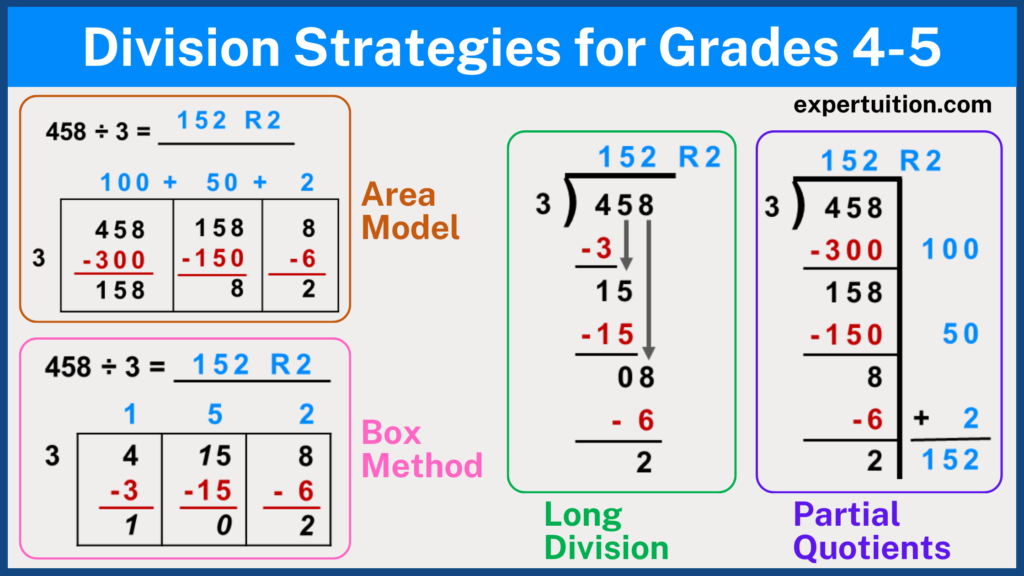Table of Contents
5 divided by 3 is a simple math problem, but it can be tricky to understand. If you divide 5 by 3, the answer is 1 with a remainder of 2, or 1.6667 as a decimal. But what does this really mean? Let’s break it down in a fun and easy way!
Imagine you have 5 chocolates and 3 friends to share them with. You give each friend 1 chocolate, but now you have 2 chocolates left. These extra chocolates are called the remainder. This is why 5 divided by 3 is 1 remainder 2. Want to learn more? Keep reading!
What Does 5 Divided by 3 Really Mean?
5 divided by 3 means we are splitting 5 into 3 equal parts. But 5 is smaller than 3 times 2, so it doesn’t divide evenly. Instead, the answer is 1 with a remainder of 2, or 1.6667 as a decimal.
When we divide numbers, we look at how many full groups we can make. In this case, one full group of 3 can fit inside 5, leaving 2 extra. This leftover part is called the remainder.
We can also write 5 ÷ 3 as a fraction: 5/3. This means 5 parts shared among 3 people. This is another way to show the answer!
Breaking Down 5 ÷ 3 in the Easiest Way
Understanding division is simple when we use real-life examples. Imagine having 5 cookies and needing to share them with 3 friends.
Each friend will get one whole cookie first. Now, there are 2 cookies left. Since we cannot give one whole cookie to each person, we break them into smaller parts. Each friend gets a little more from the remaining 2 cookies.
This is why 5 divided by 3 is 1 whole cookie per person and 2 cookies left over. This remainder is what makes the answer a mixed number (1 2/3) or a decimal (1.6667).
Understanding Remainders: Why Is There 2 Left Over
A remainder is the extra number left when division does not happen evenly. In 5 ÷ 3, we can only fit one group of 3 inside 5, leaving 2 extra.
- The number 5 is too small to make two full groups of 3.
- So, only one full group can fit.
- This leaves 2 extra pieces, which is the remainder.
Remainders appear when numbers cannot be divided evenly. In this case, 5 cannot be split into equal groups of 3 without something left over.
How to Write 5 ÷ 3 as a Fraction and Decimal

Sometimes, we don’t want to leave remainders. We can turn the remainder into a fraction or decimal to get a cleaner answer.
- As a fraction → 5 ÷ 3 is written as 5/3 or 1 2/3.
- As a decimal → 5 ÷ 3 is 1.6667 (rounded to 4 decimal places).
Both methods show the same value, but decimals are useful for money and measurements, while fractions are great for sharing food and objects.
Real-Life Examples of 5 Divided by 3
Division is everywhere in daily life. Let’s look at some common ways we use 5 ÷ 3 in real situations.
- Pizza Sharing – If you have 5 pizza slices and 3 friends, how much does each friend get? Each gets 1 slice, and the extra 2 slices can be split into smaller pieces.
- Splitting Money – If you have $5 and want to divide it among 3 people, each person gets $1.66 (rounded).
- Time Management – If you have 5 minutes and need to split it into 3 equal parts, each section is 1 minute and 40 seconds.
These examples show why division is useful in daily life!
Dividing 5 Chocolates Among 3 Friends – A Fun Example!
Let’s say you have 5 chocolates and want to share them equally with 3 friends. How much does each person get?
Each friend gets 1 whole chocolate first. Now, you have 2 chocolates left. Since you cannot give a full chocolate to each friend, you cut the 2 chocolates into 3 small pieces.
Now, each friend gets:
- 1 whole chocolate
- 2/3 of another chocolate
This means each friend gets 1 2/3 chocolates. This is the same as saying 5 ÷ 3 = 1.6667 in decimal form.
Can 5 Be Divided by 3 Without a Remainder

Some numbers divide evenly, but 5 ÷ 3 does not. There is always a remainder of 2, meaning it will never be a perfect whole number.
However, you can:
- Use fractions (5/3)
- Use decimals (1.6667)
- Round the answer to the nearest whole number (1 or 2)
These methods help when division is not exact, making numbers easier to work with!
How to Check Your Answer When Dividing 5 by 3
To check if your division is correct, you multiply the answer by the divisor and add the remainder.
Example:
- The whole number in 5 ÷ 3 is 1.
- Multiply 1 × 3 = 3.
- Add the remainder: 3 + 2 = 5.
If the final number matches the original number (5), then the answer is correct!
5 ÷ 3 in Different Math Methods – Long Division & More
Ways to Solve 5 ÷ 3:
- Long division – Divide step by step and get a decimal answer.
- Repeated subtraction – Keep subtracting 3 from 5 until you can’t anymore.
- Multiplication check – Use the multiplication method to confirm your answer.
Different methods help in different situations, so choose what works best!
Why Learning Division Is Important in Daily Life

Division helps in shopping, cooking, and sharing. When we know how to divide, we can:
- Split money or food fairly
- Manage time properly
- Solve everyday problems faster
Understanding 5 divided by 3 helps us in real-world situations, making life easier and math fun!
Conclusion
Understanding 5 divided by 3 is easy when we break it down. The answer can be written as 1 remainder 2, 5/3, or 1.6667. We can use different methods like long division, fractions, and decimals to find the answer in different ways. Learning division helps us share things, manage money, and solve problems in real life.
Math is everywhere, and division makes life easier! Whether you are splitting food, time, or money, knowing how to divide helps a lot. Now that you understand 5 ÷ 3, you can use it in everyday situations and make better decisions. Keep practicing, and math will become even more fun!
FAQs
Q: What is the answer to 5 divided by 3?
A: The answer is 1 remainder 2, or 1.6667 in decimal form. You can also write it as 5/3 in fraction form.
Q: Can 5 be divided by 3 evenly?
A: No, 5 does not divide evenly by 3. There is always a remainder of 2, making it an improper fraction or decimal.
Q: How do you write 5 ÷ 3 as a fraction?
A: 5 divided by 3 can be written as 5/3 or 1 2/3 as a mixed number.

